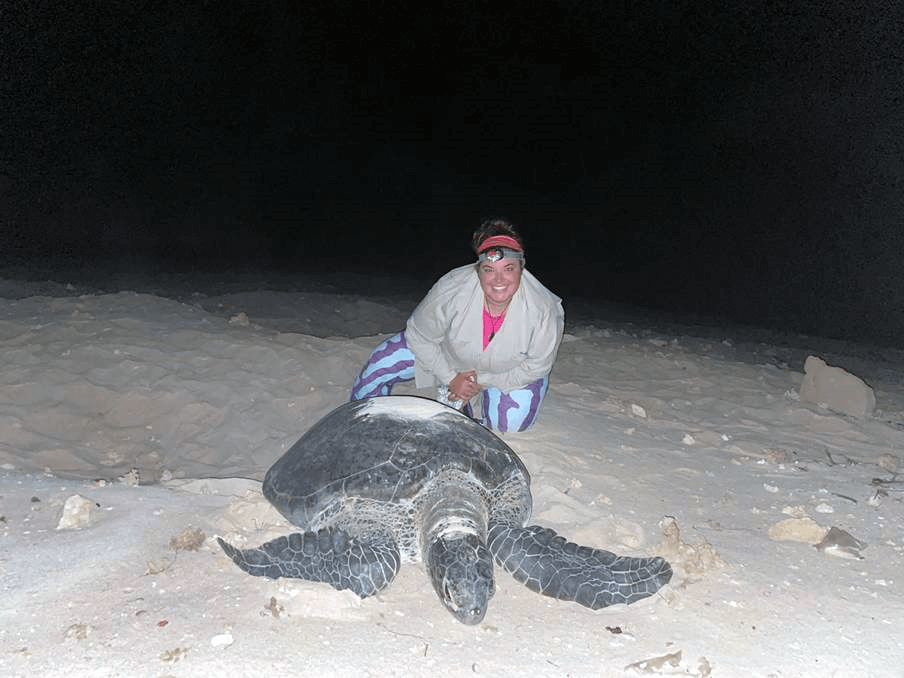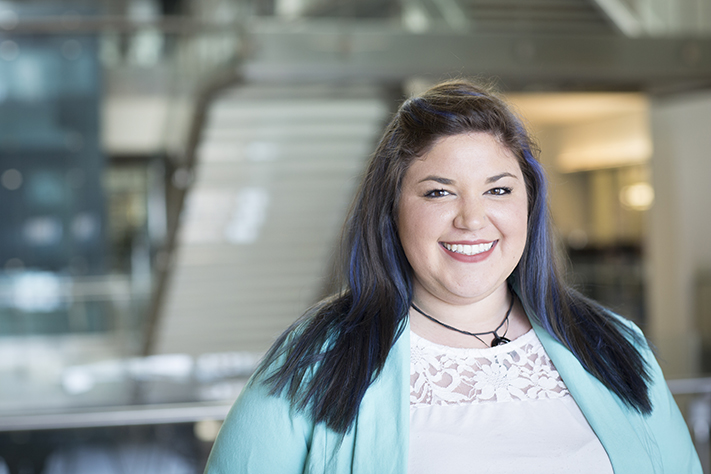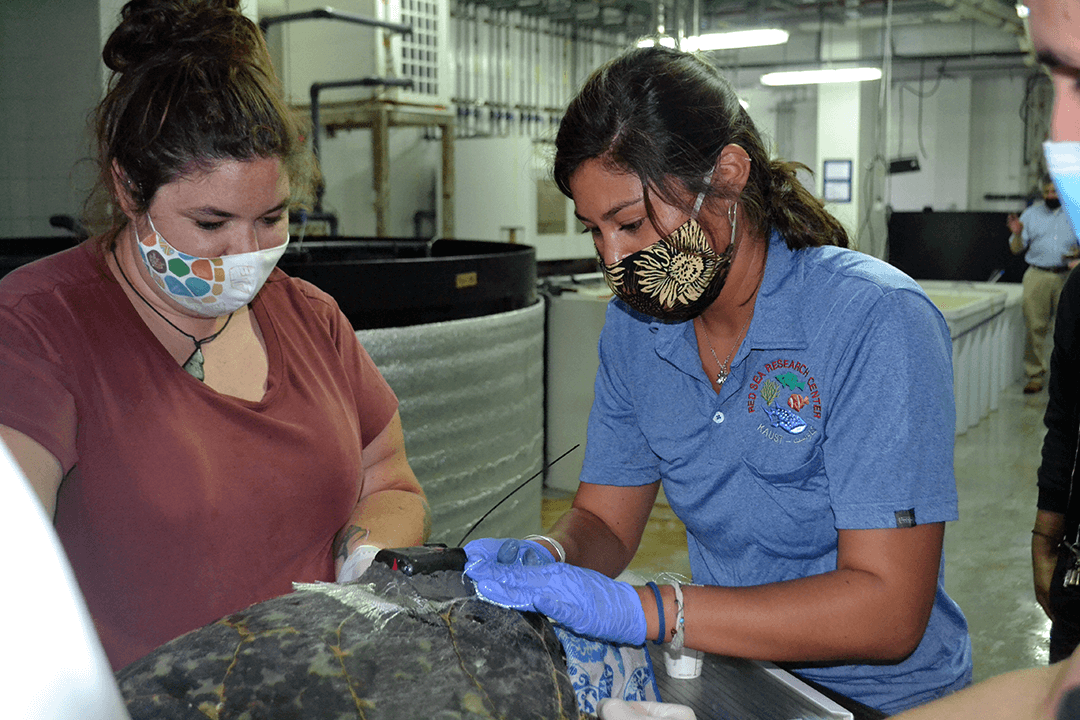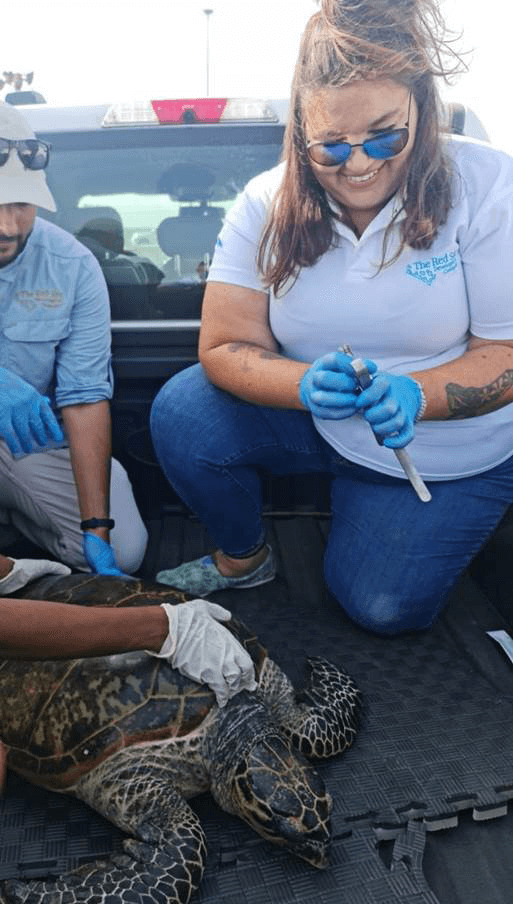KAUST alumna Royale Hardenstine devotes career to protecting the whale shark, marine animals in the Red Sea

Royale Hardenstine poses next to a sea turtle on a sandy beach in a Red Sea protected area. Photo courtesy Royale Hardenstine
Royal Hardenstine is a guest speaker at KAUST Reunion 2021 on November 13.
Click here to register.
Marine animals in the Red Sea are some of the most understudied in the world, and KAUST alumna Dr. Royale Hardenstine (Ph.D. '20, MS '15) has dedicated her career path to changing that, starting with the biggest animal out there — the whale shark.
Not much is known about Red Sea whale sharks. Some of the earliest sighting data comes from the 1930's in captains' logbooks detailing collisions with these large creatures. Throughout her master's and Ph.D. degrees, Hardenstine's research at KAUST with advisor Dr. Michael Berumen has increased understanding of these animals' movements and behavior.
"In my Ph.D., I used population genetics to show the connectivity of Red Sea whale sharks to the larger Indo-Pacific population," said Hardenstine. "I also used photo identification to look at the crossover of genetics within the Red Sea from Al Lith to Egypt, Egypt to Israel, and Egypt to Jordan, and found movements of individuals between the aggregation site in Al Lith and the neighboring aggregation in Djibouti."
Now Hardenstine widens her focus to include sea turtles, cetaceans and dugongs — species needing protection as coastal development increases in Saudi Arabia.
"I didn't know what I was going to do after finishing my Ph.D.," she said. "It's difficult to think about those big decisions while writing a dissertation and dealing with a global pandemic. It literally came down to the moment when I would have needed to think about my next move, when I received an email in my inbox that offered an opportunity to stay in Saudi Arabia."
Just like many post-graduation opportunities, this one came through networking with her Ph.D. advisors, who bring connections to The Red Sea Development Company (TRSDC). The company happened to be looking to hire someone who could research the movement ecology of protected species in the Red Sea. Hardenstine was a strong candidate.
"I was very excited that this opportunity presented itself as I was finishing up, because I really love the Red Sea," said Hardenstine. "I joke about the fact that I now get cold diving in the Red Sea, and as one of the warmest bodies of water in any given season, that would pose a challenge for me to dive and work as a marine scientist anywhere else."
Creating impact through a dream job

Portrait of KAUST alumna Royale Hardenstine, Ph.D. ’20, MS ‘15. Photo courtesy Royale Hardenstine
Hardenstine now works as the Protected Species Science Manager at TRSDC, where she spends her days monitoring the 92 reefs and islands included in the Kingdom's future Special Economic Zones, diverse sectors aimed to attract tourism and economic investment to Saudi Arabia. Her job directly impacts marine life in the Red Sea, as she has the ability to decide how to protect these areas. In order to do that, she first had to find out where these animals lived.
"When trying to understand the movement of dolphins and other cetaceans in the Red Sea, it's crazy to realize that there isn't a lot of information recorded," said Hardenstine. "For example, our team is looking at the presence and habitats of dugongs through aerial drone surveys, but they are really hard to find. The most recent recorded sightings for the Saudi Arabian Red Sea in science literature come from 1987."
As Hardenstine moved from whale sharks to other marine megafauna, she realized there are many other animals that require further study in order to conserve.
"I left my Ph.D. with many other project ideas in my head, for whale sharks and other Red Sea animals," she said. "While I do get to work on a number of new and diverse projects, as a manager I no longer have the luxury of diving into a specific niche topic, but a lot of these broader topics at TRSDC can inform KAUST Ph.D. and masters projects, which is another benefit of this job."
Ongoing collaboration with KAUST
As the Red Sea Development Company grows, they have continued to hire more KAUST graduates. The relationship between the two institutions is integral to their current goals of conservation, protection and sustainable tourism.
Hardenstine said that even though she's no longer a student at KAUST, she doesn't feel like a stranger, and that there are many opportunities where KAUST and TRSDC interact.
"I get to see many KAUST masters and Ph.D. students as well as marine science graduates during field trips. For example, masters student Areen Nasif, who uses drone surveys for green sea turtle monitoring, works with us and will inform us if she catches any dugongs on camera. Alexa Foster, another masters student, works closely with our bird science manager Dr. Licia Calabrese at TRSDC, and recently I worked with Ph.D. student Lyndsey Tanabe to tag and rehabilitate sea turtles."

Royale Hardenstine and her colleague tag sea turtles for research purposes. Photo courtesy of Hardenstine
The working relationship between TRSDC and KAUST benefits the company and the graduate students.
"By working with KAUST students, we can show them what is actually feasible in conservation research, both now and in the future," she said. "It's great for the company and my work as well, because students are very creative and have problem-solving skills that could aid in challenges that we face as we decide how to protect these reefs."
As the mission of the company is to develop Red Sea islands for sustainable tourism while also improving the local biodiversity of coral, sea grasses and marine animals in the region, Hardenstine's job to protect species is essential.
"Through some of the baseline work with Lindsay, it was found that an island being considered for development was actually one of the largest hawksbill sea turtle nesting sites in the Northern Red Sea," said Hardenstine. "This location is also where we released our three rehabilitated sea turtles earlier this year. Protecting this island and sea turtles, in general, is now a major focus for the company."
Inspiring sustainability and marine life protection

Royal Hardenstine is the Protected Species Science Manager at The Red Sea Development Company, Saudi Arabia. Photo courtesy Royale Hardenstine
From graduate student to protected species manager, Hardenstine's path also includes being an educator at TRSDC, inspiring the local community and employees to care for and protect marine life.
"Something I really like about this job is that I am not just the person who monitors and protects important habitats by informing the company where precautions are needed. I also get to educate my colleagues about why we should protect these areas," she said. "This is the part that truly makes the work I do sustainable."
Hardenstine said that some talks that she gave at a few seminars about protecting marine animals in the Red Sea inspired local community members to present their own understanding and passion for protecting these species.
"Once we educate the people as to why we need to protect a piece of land, reef or coastline, they start to care about it too, and can spread that care to their community farther than I can."
She said that education of the community is an especially important goal of TRSDC, however, not only those with degrees have knowledge worth sharing.
"I learn as much as I teach, if not more," said Hardenstine. "The boat captains who work at TRSDC and KAUST are a wealth of information. They know so much about the area and are out in the ocean every day. They inform me of animal sightings and are really excited about it. I've seen them so excited on field trips that they will jump in the water to swim with the whale sharks and be scientists themselves. I love encouraging that excitement because that is the most influential way to protect these animals."
Hardenstine's path is one truly shaped by her experience, connections and education at KAUST, and the prospects for current and incoming students are promising for those who want to work in areas of marine life conservation in the Red Sea.

